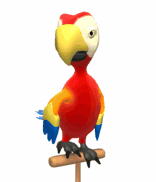
The Eastern Whipbird (Psopodes olivaceus) is found along Australia's eastern edge from northern Queensland to Victoria. It is from 26 to 30 cm long.
The crested head and breast are black. There is a white neck band. They are olive green above and grey white below. The name whipbird is given because of the bird's call. The male's call sounds like the crack of a whip and the female's call follows with a sharp "choo-choo" sound. The Western Whipbird is smaller with an olive-brown crest.
These birds are secretive, prefering to remain in dense vegetation near the ground. They like wet habitats near water.
These birds travel alone, in pairs or small family groups and feed on insects and small invertebrates.
The breeding season is from
July to December. The nest is placed on or near the ground and is made of sticks, bark and lined with grass. The clutch size is from 2 to 3 eggs. The female incubates the eggs which hatch in about 18 days. Both parents tend the young which fledge in about 12 days. There are sometimes two broods raised in a season.
This little Eastern Whipbird is only 8 inches long from head to tip of tail. Wild Republic, maker of these birds, has joined hands with CEBA to empower its new line of birds. Each bird's lifelike design and detailing is the result of input from CEBA. The sound is an actual Eastern Whipbird provided by CEBA (CEntre Bioacoustique Alpin, Europe) and made by expert recordists. Wild Republic's affiliation with this bird organization emphasizes its commitment to nature conservation.
Wild Republic has discontinued its Australian Series of birds.



